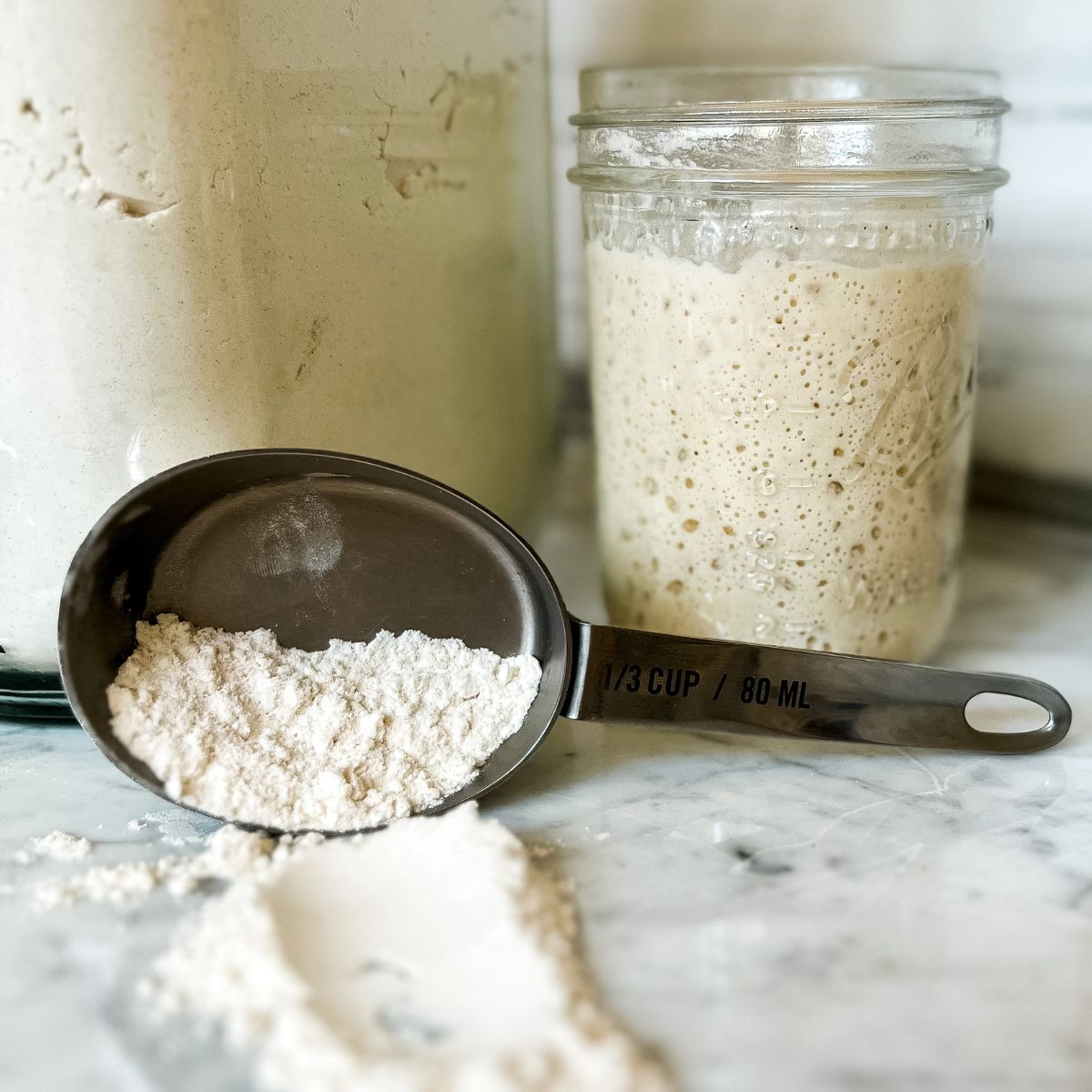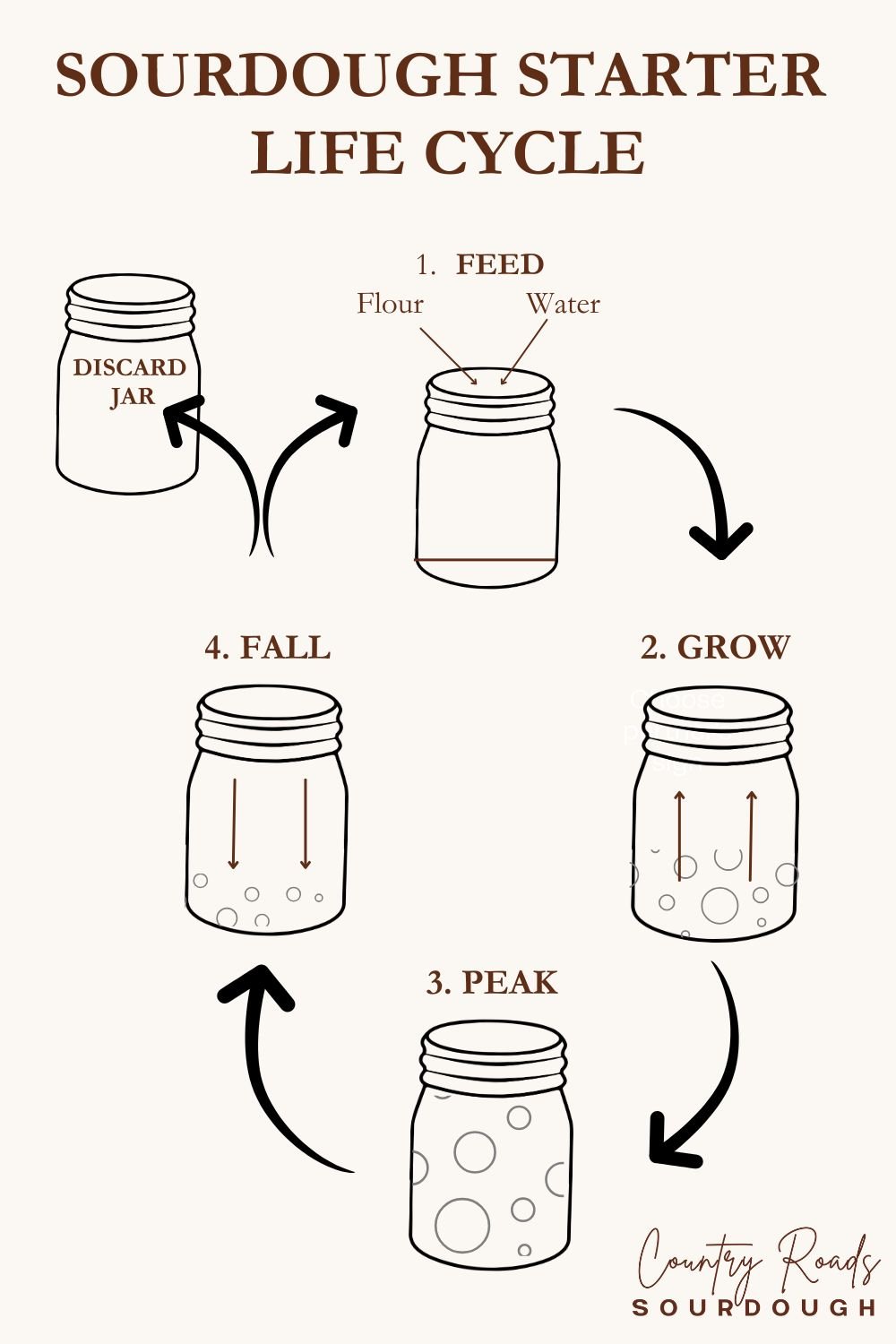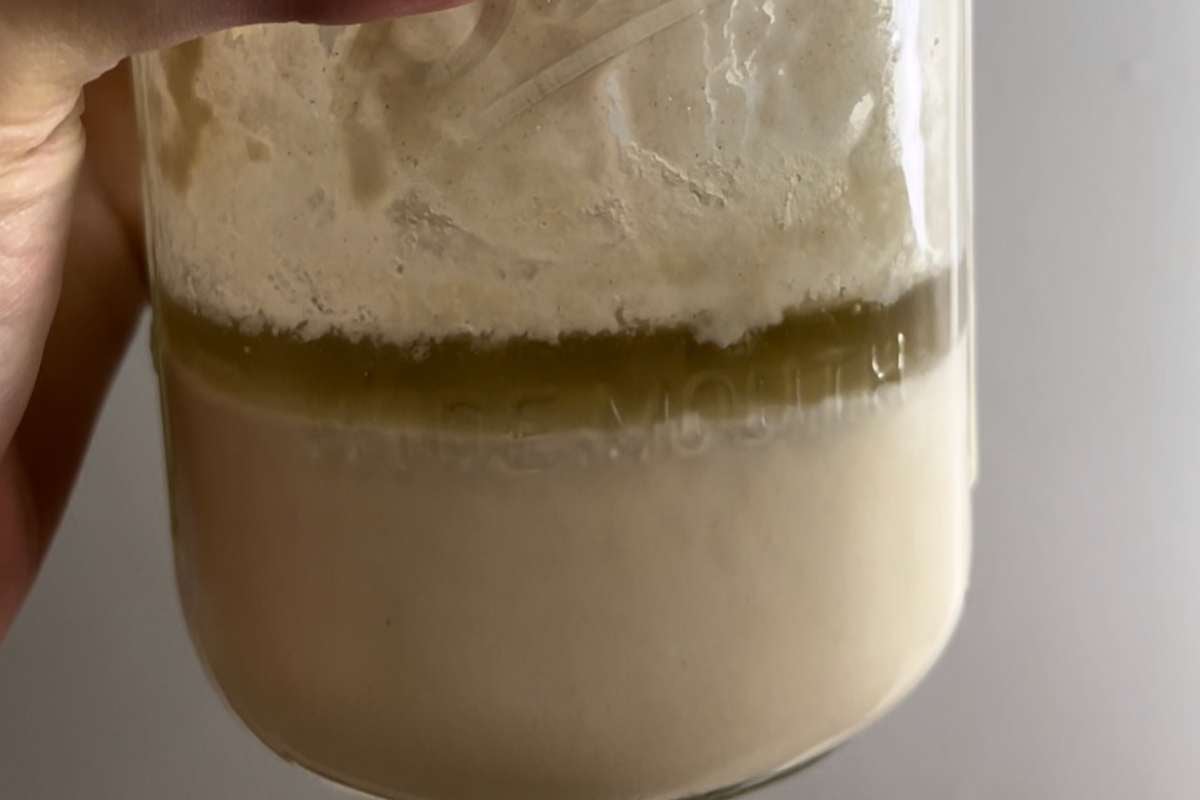The easiest way to feed & care for your sourdough starter
Feb 26, 2025
This post may contain affiliate links . Read my full Disclosure Policy.
One of the most intimidating parts of sourdough is figuring out how to make and care for a sourdough starter. Maybe you made your first sourdough starter from scratch or have had one for a while but aren’t really sure what to do with it. Don’t worry, I can help!
In this guide, I’ll walk you through the easiest way to feed and care for your sourdough starter from the fridge or counter, troubleshoot common issues, and decide on the best feeding schedule for your baking routine.

Table of Contents
- Where do I get a sourdough starter?
- What do I feed my sourdough starter?
- What should I store my sourdough starter in?
- How do I feed my sourdough starter?
- Do I need to discard?
- How much do I feed my sourdough starter?
- How often do I feed my sourdough starter?
- Where should I store my sourdough starter?
- When is my starter at peak?
- Troubleshooting
- Step-by-Step Guide to Feeding a Sourdough Starter from the Fridge
- FAQ
- Tips
Where do I get a sourdough starter?
If you’re brand new to sourdough and aren’t sure where to start check out my recipe for making a sourdough starter from scratch. Or you can buy a dehydrated starter or get a free dehydrated starter when you take my online class (if you live in the USA).
Once you get one you’ll be shocked how many recipes can be made with your sourdough starter from artisan breads, cinnamon rolls, granola bars, cheez-its, focaccias and more the possibilities are endless.
What do I feed my sourdough starter?
Feeding your sourdough starter consists of giving it flour and water.
Flour
Sourdough starters can be made with a variety of flours from all-purpose, kamut, einkorn, whole wheat, rye, and more. Whichever type of flour your starter was created with, it’s best to continue feeding it the same type, as sudden changes can shock the starter. Even switching from non-organic to organic flour can cause a temporary slowdown.
If you ever want to transition to a different type of flour, do so gradually by mixing it in over several feedings.
A common type of starter, and the one I use, is made with white flour. I typically use all-purpose flour since it’s more affordable, but bread flour works too.
While I personally prefer unbleached flour, it’s a misconception that bleached flour will kill your starter. If unbleached flour isn’t available or you simply prefer bleached, don’t worry—flour oxidation has no impact on your starter’s health.
Water
Any type of clean water should be just fine for your sourdough starter. I personally use tap water, but filtered water is also a great option.
There’s a common myth that tap water, especially chlorinated water, will kill your starter. In reality, while chlorine can slow fermentation, it won’t harm your starter in small doses. If you aren’t convinced check out The Sourdough Journey’s video where 10% bleach was added to a starter—without killing it!
Additionally, many of my online class students have had no issues using reverse osmosis or well water.
So don’t stress about using a specific type of water. But if your starter is struggling to rise, switching to filtered water might be worth a try.
What should I store my sourdough starter in?
I recommend using a straight edge, clear jar. I prefer to use a glass jar, this KneadAce jar is my favorite. But mason jars or Weck jars are good options as well. To cover the starter I recommend using the jar lid or silicone lids that will keep the moisture in. If you use the mason jar lid just be sure not to screw it on all the way as you don’t want it airtight. Using a paper towel or tea towel will dry out the top of the starter so I don’t recommend either of those.

How do I feed my sourdough starter?
Before we dive in, let’s break down the sourdough starter cycle in the simplest terms. The good bacteria and wild yeast in your starter get hungry and need to be fed to continue to leaven your breads. A feeding consists of giving your starter flour and water.
The bacteria and wild yeast “eat” the food and “blow” bubbles (CO2). The more bubbles, the more your starter rises—until it runs out of food. This stage is referred to as “peak” and is the ideal time to make your sourdough bread.
After that, the bubbles begin to pop, and the starter begins to fall back down. This is referred to as “discard” (or the leftovers). Some of the leftovers can be added to a discard jar that is left in the fridge for discard recipes and some can be fed to start the process again. If you don’t have much starter left over you do not have to discard.

There are two rules to remember when feeding your sourdough starter.
1. Feed your starter equal weight flour and water. This is referred to as 100% hydration, the most common type of starter used in sourdough recipes. If you’re measuring by volume (cups), remember that water weighs more than flour, so you’ll need to use half the amount of water compared to flour.
2. Feed your starter at least the amount in the jar or more. For example if you have 50 grams of starter in the jar, feed it at least 50 grams of flour and 50 grams of water.
Feeding your starter less than what’s in the jar is like snacking all day instead of eating a full meal—you’re left feeling unsatisfied. Underfeeding your starter will weaken it over time and leave it constantly hungry.
To feed your starter you will simply add the flour and water to the jar of starter and stir it up until the flour is fully incorporated. The texture will be a a thick batter consistency.
Do I need to discard?
If you are new to the term discard you can think of it as your leftover starter. The main reason you discard, or remove some of the starter, before a feeding is to avoid excess amounts of starter. However, if you only keep a small amount of starter, and use the majority of it when making a sourdough recipe, you don’t need to discard before feeding it again.
Discard can be fed again to continue the life cycle and/or can also be added to a discard just that is left in the fridge for discard recipes. While discard isn’t used as a leavening agent it can add moisture and flavor to your sourdough recipes.
Any discard added to your discard jar does not need to be fed and can be used indefinitely in recipes as long as there is no mold. Although, I prefer to use it within 1-2 months because it becomes more tangy as time goes on.
Some of my favorites sourdough discard recipes include sourdough pancakes, sourdough mini muffins, sourdough breakfast bars, and sourdough chocolate chip cookies.

How much do I feed my sourdough starter?
As stated earlier you want to feed your starter at least what’s in the jar. If you feed your starter the same amount as in your jar i.e. 50 grams of starter, 50 grams of flour, 50 grams of water that is considered a 1:1:1 feeding ratio. 1 part starter to 1 part flour to 1 part water. This will take about 4-5 hours to peak.
However if you need more starter or you want it to be ready later on in the day you can change the feeding ratio. So going back to our earlier example, a 1:5:5 ratio would be 50 grams of starter: 250 grams of flour: 250 grams of water. This will peak in about 10-12 hours.
So depending on how much starter you need for a recipe and how soon after feeding it you need your starter will change how much you feed it.
How often do I feed my sourdough starter?
The question of how often to feed your sourdough starter will depend on where you store your sourdough starter.
If you store your starter on the counter you should be feeding your starter every day. But if you keep your starter in the refrigerator every 7-10 days is fine. You can even go longer in between feedings in the fridge but your starter will become sluggish and will most likely require additional feedings on the counter before it is ready to bake with.

Where should I store my sourdough starter?
Depending on your preferences and how often you bake you have two options. You can either store your sourdough starter on the counter or in the fridge.
Storing sourdough starter in the fridge
Have you ever been told you have to feed your sourdough starter every single day? That idea can be overwhelming, and it’s one of the biggest reasons people give up on sourdough. It’s the reason I threw my first starter in the trash.
But the good news is there’s a much easier way to feed and care for your starter—without the daily commitment.
One of the key factors in fermentation is temperature. A warm environment speeds things up, while a cool environment slows it down. That’s where your fridge becomes a game-changer.
Storing your sourdough starter in the fridge significantly slows down fermentation, meaning fewer feedings and less maintenance. If you don’t bake often—maybe just on weekends—this method lets you keep your starter healthy without daily upkeep.
Storing sourdough starter on the counter
If you’re baking multiple times a week, keeping your starter on the counter and feeding it daily might be the better option.
Or, if your schedule is somewhere in between, you can mix both methods—keeping it on the counter for a few days, then in the fridge when you need a break. There’s no one right way—just do what works for you.
When is my starter at peak?
Starters can all look a little different depending on the type of flour used but white flour starters will have lots of bubbles around the sides and top of the starter. It will also be doubled or more in size. You will know when it is at peak when the top begins to flatten out.

If for any reason you are not quite ready to use your starter when it is at peak you can pop it in the fridge for a few hours (I wouldn’t recommend more than 12 hours) and use it for your sourdough bread recipe right from the fridge.
Troubleshooting
If at any point your starter is sluggish and not doubling in size and/or getting bubbly with each feeding don’t panic. It doesn’t mean you killed it! The best thing you can do is leave your starter on the counter and feed it daily for a couple days. It should come back! If for any reason it is still struggling make sure your starter is warm and replace a little bit (15-25%) of your white flour with whole wheat or rye flour to give your starter a boost.

Step-by-Step Guide to Feeding a Sourdough Starter from the Fridge
- Take Your Starter Out of the Fridge– You don’t have to let your starter warm up before feeding—it can be fed straight from the fridge!
- Discard- Discard some of your sourdough starter unless you don’t have much in your jar in which case you don’t have to.
- Feed your starter- Depending on how much starter you need feed your starter flour and water, ideally using a kitchen scale.
- Let your starter rise- After feeding, you have two options:
- Bake with it– Let it sit in a warm spot to rise for your next sourdough bake.
- Maintenance mode– Let the starter sit out for an hour and then place it back in the fridge.
- Refrigerate– After your starter peaks and you use it in a recipe it is now ready to put back in the fridge. If you are not going to use your starter for 7-10 days I recommend feeding your starter again before placing it in the fridge. I typically feed it and then immediately put it in the fridge. If you are going to use your starter again within the week you can put your starter in the fridge without a feeding.
If you prefer to feed your starter daily, simply discard and feed at least every 24 hours.
FAQ
I switch into a clean jar every 1-2 weeks.
Make sure you are leaving your sourdough starter in a warm spot, check out my blog post how to keep your starter warm for ideas.
No the only reason your starter is dead is if you see fuzz or pink or orange streaks which are signs of mold. A black liquid is hooch which is a natural byproduct of fermentation and just a sign your starter is hungry.
If your starter smells like acetone or acidic it is most likely hungry. Giving it a feeding or two will fix the problem.
Tips
- Choose a feeding method that works for you—refrigerated, room temperature, or a mix of both.
- Keep your starter well-fed– every 1–2 weeks for fridge storage, daily for counter storage.
- If your starter has been in the fridge for weeks, give it a couple of feedings before baking.
- Be patient with cold starter—since it starts cold it takes longer to rise so use warm water to help.
Feeding a sourdough starter doesn’t have to be complicated. With the right routine, you can maintain a healthy starter without daily upkeep. Whether you store it in the fridge, keep it on the counter, or switch between both, the key is finding what works best for your baking schedule.
Let me know in the comments—how often do you feed your starter? Do you keep it in the fridge or on the counter? I’d love to hear about your experience!






I got a dehydrated rye starter can I just add white flour or should I use rye flour
You can use white flour but it will probably take longer for it to rehydrate. Or you could do a mix of white flour and rye and then slowly wean it off rye once it is established.
Is it true that all the beneficial bacteria is killed when baking, so sourdough is no healthier than regular bread? I’m reading that everywhere.
The health benefit of sourdough comes from the long fermentation process, which breaks down the gluten making it easier to digest.